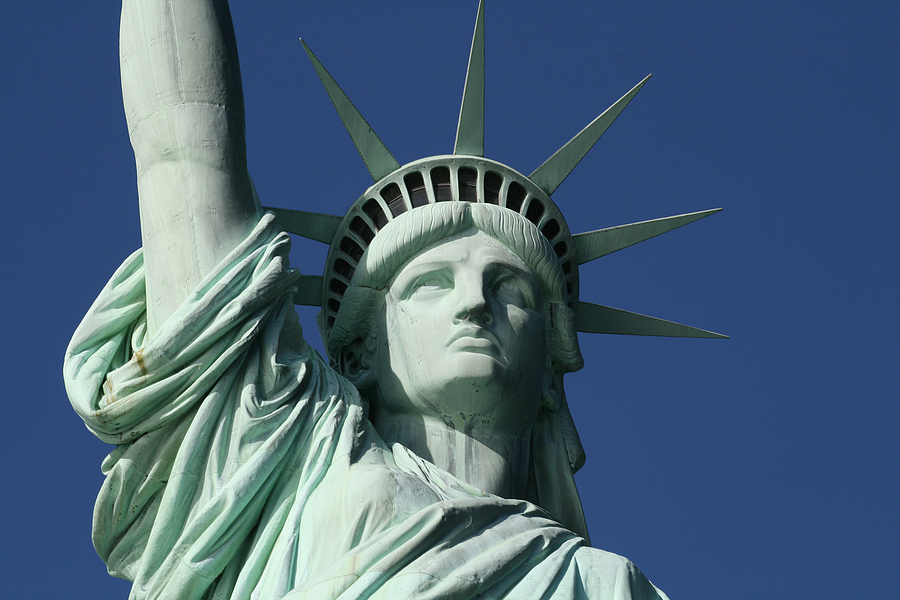On August 5, 1884, William A. Brodie laid the cornerstone of the pedestal on which the Statue of Liberty stands.
The statue is a powerful symbol of American ideals, not just for Americans but to the world. In the spring of 1989, for example, Chinese students erected a 33-foot-tall papier mâché version of the statue in Tiananmen Square. As it suppressed the student demonstration, the Chinese army destroyed the statue and with it the hope of freedom in China.
 The woman of the statue is Libertas, the Roman goddess of freedom, who emerged around 500 B.C. She wore a flowing robe, held a rod, and bore a soft cap, called a pileus. The rod and the cap symbolize freedom. When Roman slaves were emancipated, a magistrate would touch them with a special rod; they’d then be given a pileus to mark their newfound freedom.
The woman of the statue is Libertas, the Roman goddess of freedom, who emerged around 500 B.C. She wore a flowing robe, held a rod, and bore a soft cap, called a pileus. The rod and the cap symbolize freedom. When Roman slaves were emancipated, a magistrate would touch them with a special rod; they’d then be given a pileus to mark their newfound freedom.
When the Roman Republic fell, so did Libertas — along with freedom and self-government. More than a thousand years later, she burst onto the scene again during the American Revolution, when the Sons of Liberty began protesting the Stamp Act (1765) by erecting Liberty Poles, each capped by a pileus.
Libertas then joined the French Revolution. For the next century, she appeared wherever republicans attempted to create representative government. In France, she was depicted leading the charge for “liberty, equality and fraternity.” This was true in 1830, in 1848, and again in the years before the final French Revolution in 1870. In each case, French republicans were inspired by America’s example and rallied around American ideals.
Foreign admirers of American liberty (in France and elsewhere), however, faced a dilemma: American slavery. The American Revolution had hinted at, but hadn’t resolved, the hypocrisy. As the decades passed, the contradiction grew, particularly as other countries, including Mexico in 1829, Bolivia (1831), the United Kingdom (1833), and France (1848) abolished slavery.
Then came the American Civil War. For some around the world, the Civil War proved the dangers of too much freedom. Leaders in Japan, Italy and Germany turned to authoritarian regimes for their political and social models.
For diehard fans of America, however, the Civil War represented the fulfillment of the Declaration of Independence’s promises. It enabled what Abraham Lincoln’s Gettysburg Address called a “new birth of freedom.”
Once such admirer was Eduard Laboulaye. Laboulaye was a French liberal and fervent abolitionist. In 1865, at a dinner in Versailles, he proposed that the French people celebrate the end of American slavery by proposing a “memorial” to the independence of the United States and the freedom it symbolized. French sculptor Frederic Auguste Bartholdi was in attendance and dedicated his next decade to designing “Liberty Enlightening the World,” our Statue of Liberty.
Laboulaye’s purpose was not to flatter Americans. Instead, by drawing attention to American freedom, he sought to reignite the movement for liberty in France and arouse his countrymen to demand it.
“Liberty Enlightening the World” is different from the previous, revolutionary portrayals of Libertas. Rather than looking inward and leading revolutionaries across the barricades (whether in Paris or Tiananmen Square), America’s Libertas faces outward, inviting the world to join in American freedom. Her lamp is more like a lighthouse, offering safety, rather than a torch leading a charge. She wears not a hat, symbolizing her emancipation, but a crown, radiating freedom to the world’s seven continents.
This was reflected a few years later when Emma Lazarus’s poem “The New Colossus” was added to the pedestal:
“Give me your tired, your poor,
Your huddled masses yearning to breathe free …”
As the poem implies, you don’t need money to come here. America is not Monaco, offering a tax haven and playground to the wealthy. Instead, it is a place where those who value individual liberty can enjoy their freedom.
In recent years, as the border was opened to anyone claiming to be part of the tired, poor, huddled masses, the “yearning to breathe free” part of the equation has largely been overlooked.
While Americans may no longer want their country to be the world’s welfare state, America should continue to stand as its beacon of freedom.


